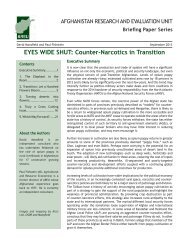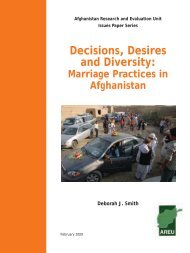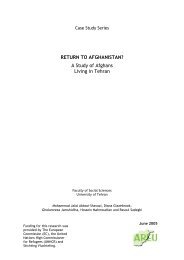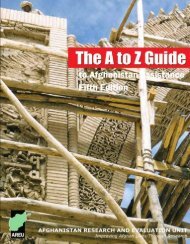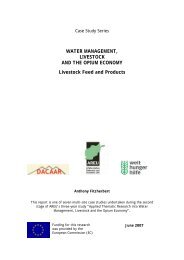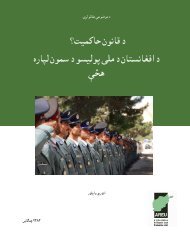Urban Livelihoods in Afghanistan - the Afghanistan Research and ...
Urban Livelihoods in Afghanistan - the Afghanistan Research and ...
Urban Livelihoods in Afghanistan - the Afghanistan Research and ...
Create successful ePaper yourself
Turn your PDF publications into a flip-book with our unique Google optimized e-Paper software.
<strong>Urban</strong> <strong>Livelihoods</strong> <strong>in</strong> <strong>Afghanistan</strong>explicitly expressed <strong>in</strong> <strong>the</strong> Government’sNational Development Framework (NDF) <strong>and</strong>Secur<strong>in</strong>g <strong>Afghanistan</strong>’s Future:Accomplishments <strong>and</strong> <strong>the</strong> Strategic PathForward (SAF). 9 A new Constitution <strong>and</strong>successful presidential <strong>and</strong> parliamentaryelections have constituted important firststeps toward stability <strong>and</strong> nationalgovernance. As <strong>the</strong> political process cont<strong>in</strong>uesto evolve, one outst<strong>and</strong><strong>in</strong>g challenge is toreform <strong>the</strong> bureaucracy. While publicadm<strong>in</strong>istration is highly centralised on paper,it has weak l<strong>in</strong>ks with <strong>and</strong> control overprov<strong>in</strong>ces <strong>and</strong> municipalities, which, takentoge<strong>the</strong>r, have been largely <strong>in</strong>effective todate <strong>in</strong> achiev<strong>in</strong>g local level economicdevelopment, governance <strong>and</strong> servicedelivery. There is a critical tension between<strong>the</strong> national imperative to streng<strong>the</strong>n <strong>the</strong>centre <strong>and</strong> <strong>the</strong> need at <strong>the</strong> city level toensure that effective municipal structures<strong>and</strong> processes are developed <strong>and</strong> supported.At present, only a small proportion of <strong>the</strong>population, ma<strong>in</strong>ly <strong>the</strong> urban <strong>and</strong> prov<strong>in</strong>cialelites, makes a decent liv<strong>in</strong>g <strong>and</strong> has accessto local level services such as good healthcare,education, safe water supply <strong>and</strong>sanitation. Access to urban labour markets,<strong>in</strong>frastructure <strong>and</strong> services must be extendedto <strong>the</strong> poor <strong>and</strong> vulnerable. This will <strong>in</strong>volvebreak<strong>in</strong>g down exist<strong>in</strong>g power structures <strong>and</strong>remov<strong>in</strong>g <strong>the</strong> <strong>in</strong>fluence of vested <strong>in</strong>terests— goals which may be formidable yet notimpossible to achieve.2.2 Susta<strong>in</strong>able urban livelihoods:Fram<strong>in</strong>g <strong>the</strong> analysisThe term “livelihoods” has been used to referto assets, <strong>in</strong>come-generat<strong>in</strong>g activities <strong>and</strong><strong>the</strong> access to both (mediated by <strong>in</strong>stitutional<strong>and</strong> social relations). Toge<strong>the</strong>r, <strong>the</strong>seelements determ<strong>in</strong>e an <strong>in</strong>dividual’s or ahousehold’s quality of life. 10 The idea ofsusta<strong>in</strong>able livelihoods became very <strong>in</strong>fluential<strong>in</strong> <strong>the</strong> development community among thosewho recognized <strong>the</strong> need to move beyondmoney-metric concepts of poverty to <strong>in</strong>cludea more holistic <strong>and</strong> dynamic underst<strong>and</strong><strong>in</strong>gof deprivation. Influenced by Amartya Sen’sanalysis of poverty <strong>and</strong> Robert Chambers’exploration of risk <strong>and</strong> vulnerability,development practitioners started look<strong>in</strong>g atlivelihoods with a multidimensional approachto social disadvantage, pay<strong>in</strong>g attention topeople’s vulnerabilities, capabilities <strong>and</strong>endowments. 11 Such an approach regardeda household’s livelihood susta<strong>in</strong>able when itallows <strong>the</strong> family to cope with economicstresses, recover from shocks <strong>and</strong> consistentlyma<strong>in</strong>ta<strong>in</strong> or enhance its f<strong>in</strong>ancial capabilities<strong>and</strong> assets without deplet<strong>in</strong>g its naturalresource base.A common feature across exist<strong>in</strong>g livelihoodsframeworks is <strong>the</strong> assessment of <strong>the</strong> strengthof people’s “capitals” or “assets”. One of<strong>the</strong> most widely adapted frameworks is <strong>the</strong>Susta<strong>in</strong>able <strong>Livelihoods</strong> Framework (SLF),developed by <strong>the</strong> United K<strong>in</strong>gdom’sDepartment for International Development(DFID). The SLF identifies five types of capital:human, f<strong>in</strong>ancial, physical, social <strong>and</strong>natural. 12 Human capital constitutes <strong>the</strong>labour resources available to households <strong>and</strong><strong>the</strong>ir quality. F<strong>in</strong>ancial capital refers to <strong>the</strong>sav<strong>in</strong>gs, credit, remittances <strong>and</strong> pensions,which allow households different <strong>in</strong>comestreams <strong>and</strong> livelihood options. Physicalcapital comprises basic <strong>in</strong>frastructure suchas hous<strong>in</strong>g, transport, water supply <strong>and</strong>communications, as well as <strong>the</strong> equipment<strong>and</strong> tools by which people pursue <strong>the</strong>irlivelihoods. Natural capital refers to naturalresources useful to livelihoods such as l<strong>and</strong>,water <strong>and</strong> public resources: rivers or common9 GoA (2004), Secur<strong>in</strong>g <strong>Afghanistan</strong>’s Future: Accomplishments <strong>and</strong> <strong>the</strong> Strategic Path Forward (SAF), Kabul: GoA.10 Ellis, F. (2000), Rural <strong>Livelihoods</strong> <strong>and</strong> Diversity <strong>in</strong> Develop<strong>in</strong>g Countries, Oxford: Oxford University Press, p. 10.11 Sen, A.K. (1999), Development as Freedom, Oxford: Oxford University Press; Chambers, R. <strong>and</strong> G. Conway (1992), Susta<strong>in</strong>ableRural <strong>Livelihoods</strong>: Practical Concepts for <strong>the</strong> 21st Century, IDS Discussion Paper No. 296, Brighton:IDS, University of Sussex.12 Carney, D. (1998), Implement<strong>in</strong>g <strong>the</strong> Susta<strong>in</strong>able <strong>Livelihoods</strong> Approach, <strong>in</strong> D. Carney (ed.), Susta<strong>in</strong>able Rural <strong>Livelihoods</strong>:What Contribution Can we Make? London: Department for International Development, pp. 3-23.<strong>Afghanistan</strong> <strong>Research</strong> <strong>and</strong> Evaluation Unit 11



